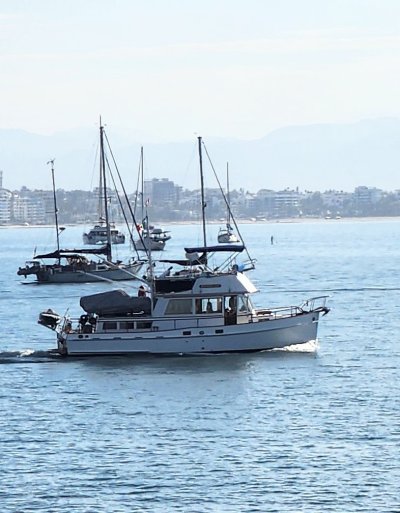Since it is offseason now, is time to study, research and learn more for the upccoming season from the experts here.
Am new to powerboating.
New to the Grand Banks.
We have a 42 Classic, twin screw, no stabilizers.
Looking for advice specifically related to heavy weather handling.
By way of background, have been a deep keel monohull offshore sailor.
Have been in all conditions, squalls, bad weather, big waves, chop, etc and know how to steer through waves upwind and off the wind, reef, heave-to, pretty much deal with anything - in a deep keel monohull offshore suitable sailboat. Am very comfortable dealing with whatever.
Have zero (or very little) experience with any of that in a powerboat.
We are older now and do not intend to go out when the weather is bad.
We will be much more circumspect and mindful and only intend to coastal cruise and visit the Great Lakes.
However, I know at some point something will happen where we will end up being in crappy weather either due to an incorrect forecast or squall or whatever and so I want some basic advice I can store away in the back of my mind to pull out when needed.
The Grand Banks 42 is fine forward and flat aft, semi displacement.
Has full length keel for tracking well, but not weighted with lead like I am used to.
What are the specific heavy weather strategies for:
Upwind with seas.
Off-the-wind with seas.
Quartering seas.
Following seas.
What are the driving techniques and throttle/speed control techniques I should be aware of and start practicing?
Looking for input from those who have been there and done that and not just necessarily on a GB but any similiar style vessel.
What do you old salts recommend and advise for technique?
Please advise
Thank you
Am new to powerboating.
New to the Grand Banks.
We have a 42 Classic, twin screw, no stabilizers.
Looking for advice specifically related to heavy weather handling.
By way of background, have been a deep keel monohull offshore sailor.
Have been in all conditions, squalls, bad weather, big waves, chop, etc and know how to steer through waves upwind and off the wind, reef, heave-to, pretty much deal with anything - in a deep keel monohull offshore suitable sailboat. Am very comfortable dealing with whatever.
Have zero (or very little) experience with any of that in a powerboat.
We are older now and do not intend to go out when the weather is bad.
We will be much more circumspect and mindful and only intend to coastal cruise and visit the Great Lakes.
However, I know at some point something will happen where we will end up being in crappy weather either due to an incorrect forecast or squall or whatever and so I want some basic advice I can store away in the back of my mind to pull out when needed.
The Grand Banks 42 is fine forward and flat aft, semi displacement.
Has full length keel for tracking well, but not weighted with lead like I am used to.
What are the specific heavy weather strategies for:
Upwind with seas.
Off-the-wind with seas.
Quartering seas.
Following seas.
What are the driving techniques and throttle/speed control techniques I should be aware of and start practicing?
Looking for input from those who have been there and done that and not just necessarily on a GB but any similiar style vessel.
What do you old salts recommend and advise for technique?
Please advise
Thank you

